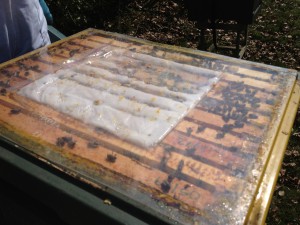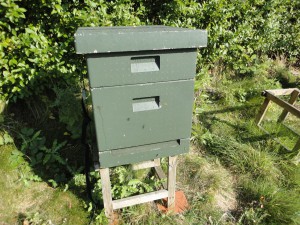It’s early spring and the sight of worker bees returning to the hive with full pollen baskets is a strong sign that the Queen inside has started to lay eggs in earnest for the start of the foraging season.
During the winter, the bees tend to consume stores from the bottom and work their way up the combs through the hive until they become resident just under the roof, typically either close to or even in the super itself. It’s at this point that the Queen starts laying eggs again and if this happens to be in the super, your going to have a real job in your first spring inspection finding and moving the Queen below your re-inserted Queen excluder.
This is made all the more difficult because early in the spring, the outside temperatures are marginal and you don’t want to chill the bees and especially the brood by exposing frames and manipulating bees in the open air for too long. For those of us with polystyrene hives, the high levels of insulation typically means the Queen starts laying earlier than she might in a wooden hive and therefore the potential of your Queen laying in the super is much more likely.
So, on the one hand you want to inspect the hive early as possible to check on the bees, and keep the Queen out of the super, but on the other hand you don’t want to risk the health of the colony by chilling them… This is why “under supering” or flipping beehives in the previous Autumn is so useful.
Once you have harvested your honey in August, leaving a full super on the hive for the bees as insurance for the possibility of a long or hard winter to come, you can lift off the brood chamber, clean out the floor and then place the full super on the base with the brood chamber on top and remove the Queen excluder. So now the hive looks like this…

You can now put back any extracted supers that you want the bees to clean up briefly for a day or two and soon after apply any Varroa treatment directly onto the brood frames without having to remove and replace the full super, saving your back and minimising disturbance to the bees. The hive can now stay in this configuration right through until next April. Any Oxalic acid treatment will be channeled directly between the brood frames and get to the bees much more effectively and you can also apply thin patties of sugar candy on top of the brood frames under the roof as shown here.

The clear plastic cover allows us to see how the bees are doing down in the combs without opening the hive unnecessarily and if the bees do start eating through the candy, then you can quickly replace the patties as required.
We can now relax through early spring knowing that if the Queen starts laying early in the year it will be close to the top of the hive – in the brood box. We can therefore delay our full spring inspection until it really is warm enough to go (3 or 4 days at 15C plus) through the hive inspecting the brood frames up close for any sign of disease or other problems.
During this inspection we can take off the brood and super, clean or replace the floor and then place the brood box back in place followed by the queen excluder and then the super on top ready for the main nectar flows in April, May and June, adding further supers as required.

This process minimises any major disturbance to the colony, especially in early spring and in late summer/autumn and ensures that the Queen stays where you want her.